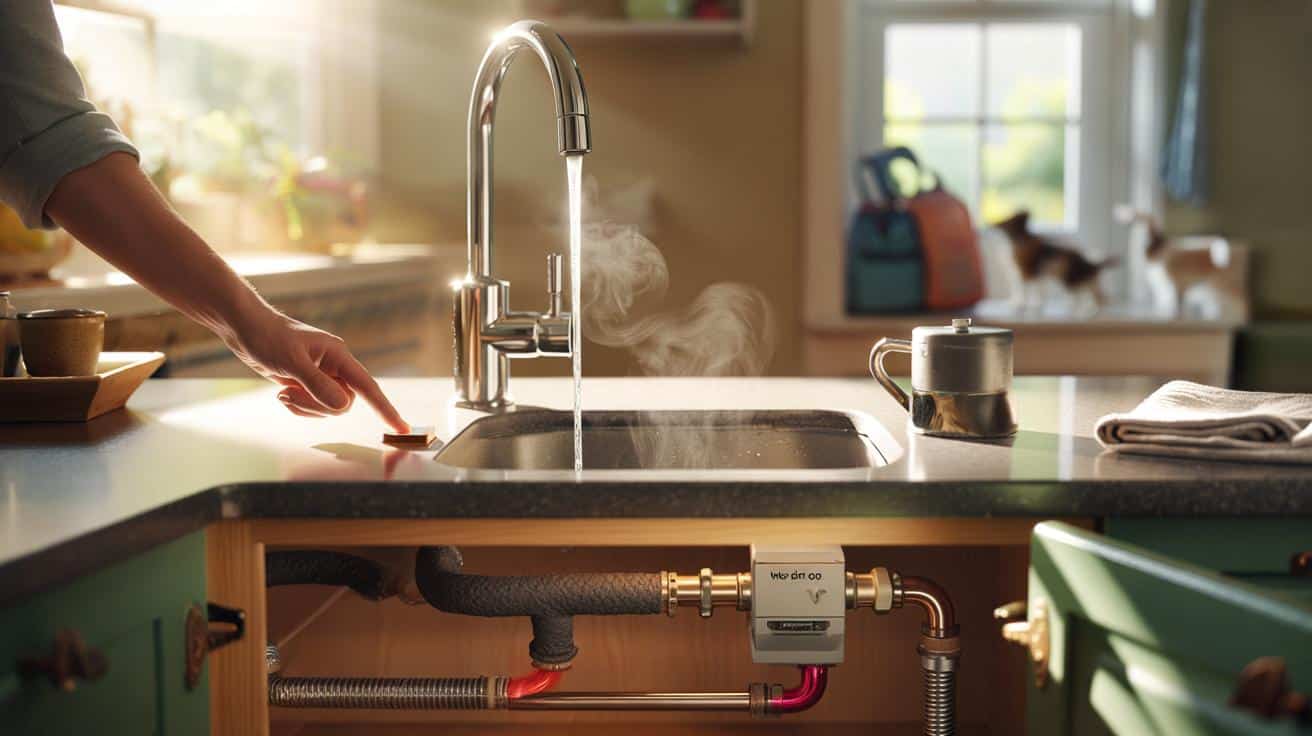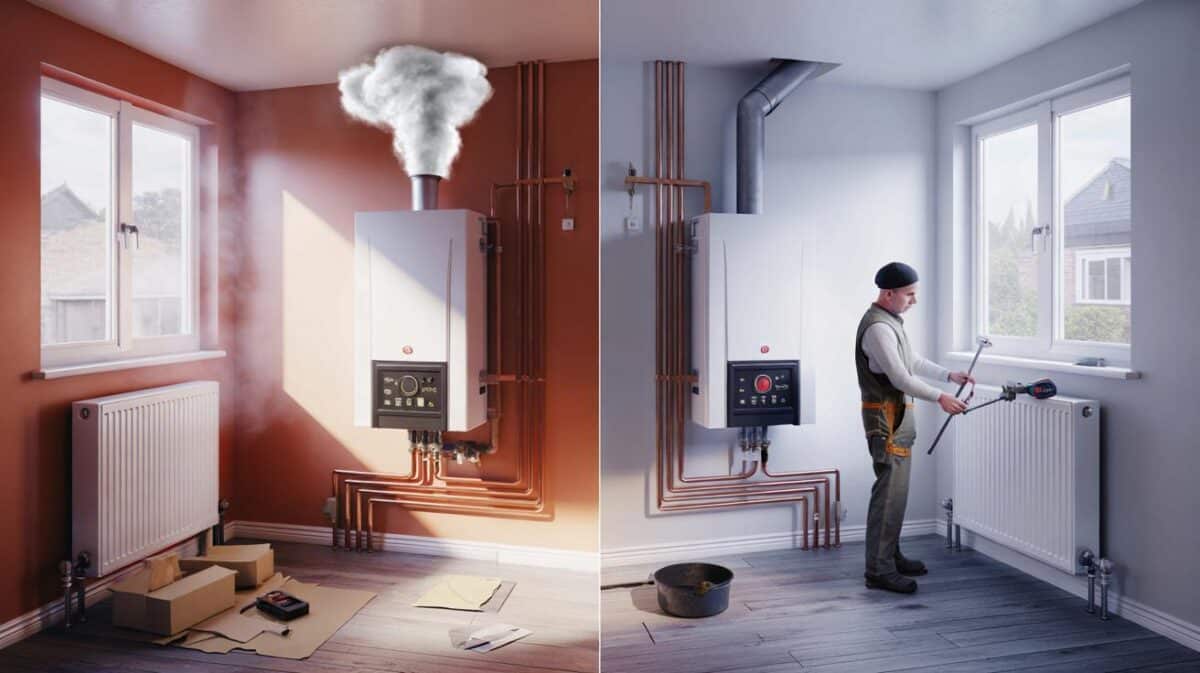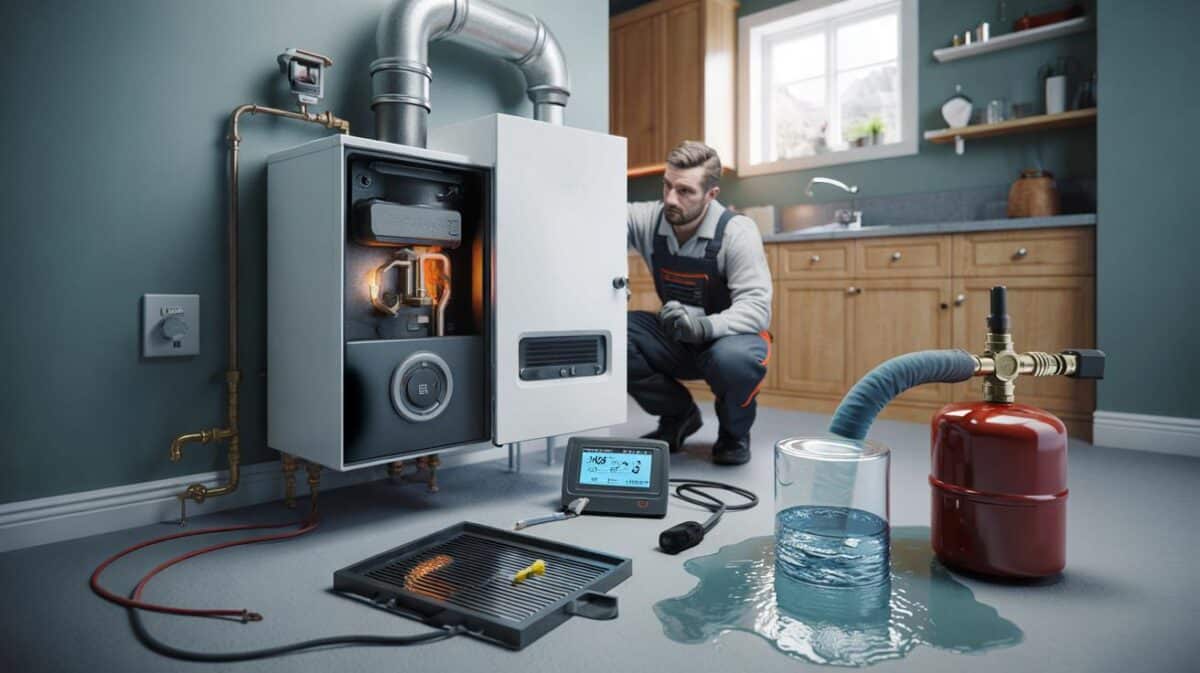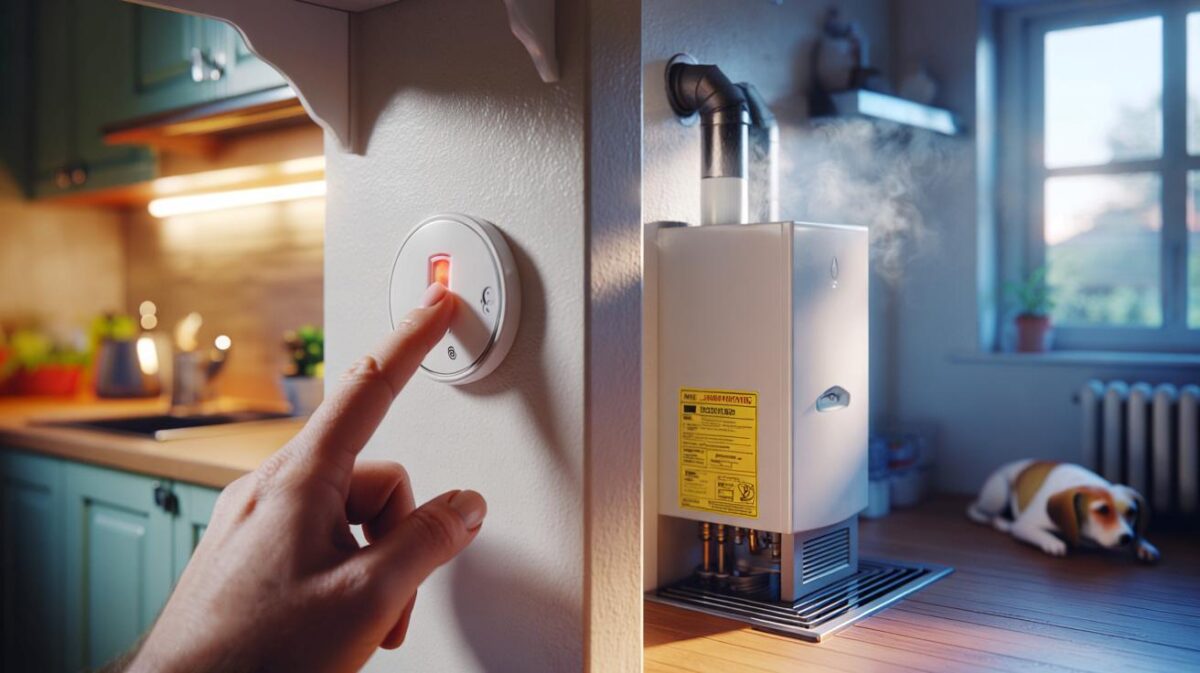You turn the hot tap and nothing happens for ages. The bill ticks up, the planet groans, and your hands stay cold — every single morning.
The kettle clicks, a school bag slumps by the door, and a tired finger flips the hot tap to life with that hopeful little twist we all know. A thin rope of water runs, perfectly cold, as if nothing you did yesterday mattered to the pipe today.
I stand there rubbing my hands, listening to the boiler stir in the other room, counting under my breath while a litre, then two, spin away. The dog thinks it’s a game; I’m watching the meter. Later, a heating engineer shows me a thumb-sized button under the sink. He presses it once, the pipes hum, and the tap turns warm in seconds. The trick was invisible.
Why hot water takes so long to arrive
The water you want lives far from the sink you’re standing at. Between them sits a “cold slug” in the pipe — yesterday’s hot, cooled overnight — and your tap has to shove it all the way back to the cylinder or boiler before real heat arrives. Longer runs mean more slug, and thinner trickles move it slower.
In one Leeds terrace I visited, the kitchen tap was 12 metres from the cylinder. At roughly 0.15 litres per metre of 15mm copper, that’s about 1.8 litres just to clear the line. At 5 litres per minute on a mixer tap, you’d expect 20–25 seconds, yet she timed 50 on a frosty morning because the first warm water still cooled against the pipe walls.
Combi boilers add their own pause. They sense flow, spark, and ramp the plate heat exchanger, which takes a handful of seconds before useful heat moves. Cylinders don’t need to fire, but their branches can be longer. If you run the tap at a dribble, you lengthen the wait because the slug moves slowly and keeps losing heat into the pipe.
Fixes that actually get hot water faster
The fastest win is a demand recirculation pump. A small under-sink unit bridges the hot and cold lines with a temperature sensor; tap a wireless button or use a motion trigger, and it pushes the cooled hot water back through the cold line until the hot reaches the sink. No water down the drain, no waiting at the tap.
Many British homes can fit one beneath the farthest basin in under an hour. Think Grundfos Comfort PM with a crossover valve, or a similar on-demand kit paired with a smart plug and a door sensor. Press, wait 10–20 seconds while the loop warms, then open the tap to instant heat. You can schedule it for the morning rush or trigger it from your phone before you reach the bathroom.
Pipe insulation is the quiet co-star. Wrap the first 2–3 metres from the cylinder or combi, then every exposed run you can reach in the loft or under floors. You keep yesterday’s heat longer and shrink that cold slug. If you have a combi, check the “preheat” or “comfort” setting — Worcester, Vaillant and others keep the hot side of the exchanger warm — which trades a whisper of standby gas for snap-fast hot water at the tap.
Common mistakes and small, human fixes
People try to turn the tap to a slow trickle to “save” water while they wait. That just prolongs the purge and wastes more in total. Open the hot tap fully, get it hot quickly, then throttle to the flow you want.
We’ve all had that moment when you promise to catch every cold-first second in a jug for the houseplants. Let’s be honest: no one really does that every day. If you won’t keep up with that routine, a demand pump or a tiny point-of-use heater under the remote basin does the job without the guilt.
A quick safety note: store cylinder water at about 60°C to tackle Legionella, then use thermostatic mixing valves to deliver safe temperatures at taps. It’s oddly calming to press a little button and know hot water is already on its way.
“The sweet spot is on‑demand recirculation with insulation,” says Ben, a South London heating engineer. “No endless pumping, no wasted litres — just heat when you actually need it.”
- Demand recirculation button near the sink
- Insulate hot and secondary-return pipework
- Enable combi preheat on a smart schedule
- Point‑of‑use 5–10L heater for the outlier tap
- Thermostatic mixing for safety at 60°C storage
The numbers, the hacks, and when to rethink your layout
A long dead-leg is the villain in most homes, and it’s measurable. A 15-metre, 15mm run holds roughly 2.3 litres; at 4 litres per minute on a water-saving aerator, you wait over 30 seconds before true heat has cleared, then more while the tap body warms. On a combi in eco mode, add ignition time and plate warm-up, and you’re nudging a minute.
Two practical angles fix this without ripping floors up. First, reduce heat loss and standby time: insulate, add demand recirculation, and give the combi a morning preheat window. Second, shrink the hot-water journey at the fixture: a compact under-sink heater for a guest WC or attic office solves the “one remote tap” problem neatly, using a few pence a day for real convenience.
The long game is design. If you ever remodel, consider a manifold “home-run” layout in 10mm PEX so each tap has a short, direct line. Bring the cylinder or combi closer to the busiest fixtures, or specify a secondary-return loop with a bronze pump on an aquastat so it runs only when the pipe cools. You feel the benefit every single day.
What it feels like when it just works
You walk up to the basin, tap a hidden button as you reach for the toothpaste, and by the time you spit, the water is already warm. No rush, no waste, no mental tally of litres sliding away. That small act turns waiting into nothing at all.
In homes with a combi, a timed preheat from 6:30 to 8:30 can make mornings flow without burning gas all day. In bigger places with cylinders, an insulated secondary return on a smart controller keeps the loop warm when you’re likely to use it, then lets it drift when you’re not. It’s not gadgetry for its own sake; it’s rhythm.
You feel the house as a system rather than a set of awkward moments. Share it with the neighbour who always complains about the cold kitchen tap. Ask your plumber what’s feasible in your layout and budget. *Small upgrades stack into comfort you notice more than you expect.*
| Point clé | Détail | Intérêt pour le lecteur |
|---|---|---|
| On‑demand recirculation | Under‑sink pump bridges hot/cold and pre‑warms the line at a button press | Instant hot without wasting water down the drain |
| Insulation + preheat | Lag hot runs; enable combi “comfort” or schedule preheat windows | Shorter waits, lower loss, better mornings |
| Point‑of‑use heater | 5–10L under‑basin unit for remote taps or loft bathrooms | Local hot water in seconds without replumbing the house |
FAQ :
- Will a recirculation pump raise my energy bills?A constant loop will, but a demand‑only pump runs for seconds at a time and is cheap to operate. Pair it with insulation for the best balance.
- Can I fit a demand pump with a combi boiler?Yes — under‑sink kits that return via the cold line work well with combis, because they don’t rely on a cylinder return pipe.
- Is turning up my water heater the right move?Store at about 60°C for hygiene, then use thermostatic mixers at taps to prevent scalding. Raising beyond that won’t speed the first arrival.
- Why is my kitchen slower than the bathroom?It’s usually further from the heat source with more elbows and smaller bore. The longer the dead-leg, the longer the wait.
- Are boiling‑water taps a solution?They’re brilliant for tea, not for hot washing. They don’t heat your whole hot line or replace a recirculation loop.







